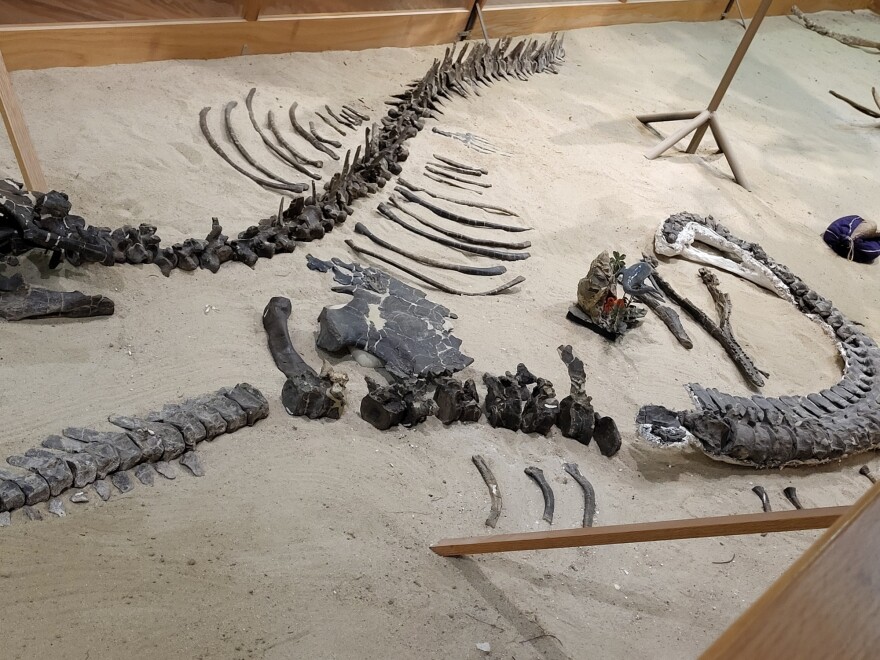Our weekly series “Dig This!” explores fossil finds in the Mountain Region.
Last week, we took you to Glenrock, Wyoming, to join in on a full-scale dinosaur dig to hear what exciting new finds researchers are digging up.
In this week’s story, Orlinda Worthington tells us where you can see those fossils, including one that you won’t see anywhere else in the world.
The sagebrush dotted hills of Glenrock, Wyoming, may look unassuming, but underground there is a wealth of hidden fossils that scientists and students from all over the world come to unearth.
“So we've got our very big footprints. I think that could be the forepaw from our big animal. Look how wide this is. And this is definitely a quadruped,” said Dr. Scott Persons.
After paleontologists pull scales, bones, teeth and claws from the earth, they are put back together at the Glenrock Paleon Museum.
“I am a bone biddy. One of five.” OW: “Tell me what defines a bone biddy. It’s a loving term I understand.” “It is a loving term, and it is just this… we work with the bones,” Lorna Keyfauver said.
Bone Biddy is the name affectionately given to Lorna and the other four volunteers who spend 12 hours a week painstakingly cleaning, brushing and scraping on bones to reconstruct the fossils fund the nearby Glenrock Exposure
“Here you see the teeth. This is a jaw.”
The lower jaw of a triceratops that once roamed this area of Wyoming.
Seventy million years later - give or take - it ended up here, on a turntable in front of Lorna Keyfauver, in the prep lab in the museum’s back room. She hunches over a table piled with pieces of bones, puts on her glasses, clicks on a bright desk light and gets to work.
“They brought it in from the field and what’s happened is it hasn’t been covered long enough and it’s soft and it broke up. And so this is what I’m working with.”
And, they use some pretty high-tech tools for the job.
“Toothbrushes and old dental picks. And then we have our little paint brushes,” Keyfauver said.
Lorna shows off one brand new tool that’s been a big help.
“It’s an air tool and it’s like a little jackhammer so that we can get into some of these smaller places.”
She shakes a box of very small bone fragments from another specimen.
There looks to be at least a hundred pieces. Although a young boy on a recent tour speculated she had a lot more.
“He goes, that’s a million trillion pieces lady,” Keyfauver said
Pieces that don’t fit go in the bone bucket. Visitors get to dig in and take a piece of a dinosaur home.
Lorna expects it will take eight weeks to fit this jigsaw puzzle of a “million trillion pieces” of bone together into a recognizable form.
Once stabilized and reconstructed, the fossils go on display at the tiny museum in the center of town. The Glenrock Paleon boasts a variety of dinosaur species and the only fossil remains in the world of a 12-foot long Plesiosaurus, a large marine

reptile that lived during the Early Jurassic period.
The museum is run by volunteers, including Executive Director Don Smith.
“All the reproductions that are up there of the teeth, the claws, things that people like to buy, we make right here. We have our own molding and casting lab,” Smith said.
While most of the volunteers are retired, there’s one younger recruit, Josephine. She’s been a volunteer tour guide and bone prepper since she was 13.
“This is a relaxing thing for me. And I’m also interested in how all of this came to be. I’m gonna continue this all throughout my career. I’m gonna be either in the prep lab or out in the field,” Josephine said.
While Josephine is volunteering to gain career experience, Lorna, who’s been at this for 15 years, says discovering the mystery of fossils helped her discover a new purpose in retirement.
“OW: And how does it make you feel doing this, this kind of work? “Um, if someone would have told me at my age I would be playing in the dirt and with bones, I would have laughed at them. It's very satisfying. Every bone tells a story. And this is to go in the museum here possibly. And so you're really creating something that is going to live on long after you,” Keyvauver said.
In Glenrock, Wyoming, I’m Orlinda Worthington.
The Paleon Museum is open during the summertime Thursdays through Saturdays. Visit https://www.paleonmuseum.org the for details on visiting and booking a tour to a dig site.



